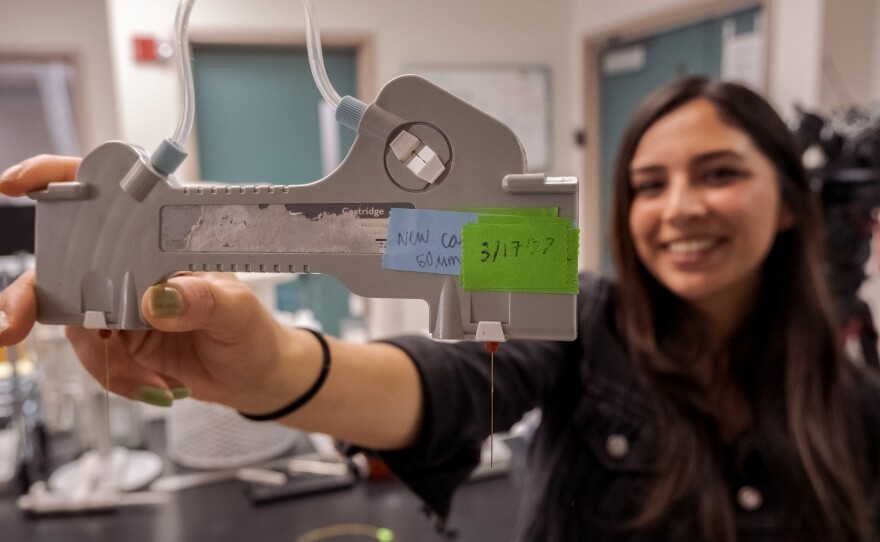Jessica Torres shows me a tiny glass tube she uses to sort through molecules. Torres, a researcher in a chemistry lab at San Diego State University, can tell by the molecules' movement what kind they are, and hopes to use this method to see signs of life in material gathered from Mars.
But finding life signs on the surface of Mars can seem like a daunting task — there’s no water, and it has punishing solar rays and a high-salt content.
“If there was life to be detected on Mars, it would be in porous rocks or the underside of rocks,” Torres said. “Somewhere that’s kind of shielded from the harsh environment that is Mars.”
Life on other planets is something many imagine. But so far there’s no proof that life exists anywhere but Earth. That’s why Torres and her advisor, chemistry professor Chris Harrison, are working on a way to find molecular traces of life on Mars.
But they're not talking about complex or intelligent life — more likely microorganisms.
RELATED: NASA Rover Lands On Mars To Look For Signs Of Ancient Life
Harrison, an analytical chemist, said the goal of his lab is not really to find life on Mars, but to find evidence it once existed.
“We’re looking for the building-block molecules that make life function, so specifically amino acids,” he said. ”These are the little LEGO blocks that you assemble in the right sequence and you get different proteins and enzymes and the functional components of cells.”

The glass tube they use to sort out life-building molecules has a channel that's more narrow than a human hair. Molecules suspended in water pass through at different speeds, depending on their size and their electrical charge. This race through the tube could determine if you're looking at an amino acid.
If their instrument hitched a ride on a rocket and given to a Mars rover, the tube could be encased in a clear cartridge a little more than an inch long and used to study Mars' surface.
Torres said NASA's Jet Propulsion Laboratory, a partner in their study, has found a place on Earth that’s a little like Mars to test such instruments: the Atacama Desert in Chile.
“It does receive very low rainfall throughout the year,” she said. ”They’ve tested their soil samples and have detected very low levels of fatty acids and other biosignatures in that soil. Which is pretty great since it means their technology would be very suitable for a Mars-like environment.”
NASA has been successfully landing on Mars since the 1970s, and the first images from the planet showed a perfectly barren landscape. But eventually they did find evidence of old riverbeds, likely formed by past water flows.
RELATED: Perseverance's Video Cameras Capture Its Arrival On Mars (There's Audio, Too)
Today, the Mars rover Perseverance is parked on a dry river delta, collecting sedimentary rocks that could harbor signs of life.
Michael Meyer, NASA’s lead scientist for the Mars Exploration Program, said the space agency will try to transport Mars samples to Earth. The elaborate plan is to land rocket-carrying space vehicles on Mars. Upon arrival, they send a ”fetch” rover to obtain samples, blast them into space and deliver them to earthbound laboratories.

If scientists find proof that life once existed on Mars, that could change our conception of life in the universe, Meyer said.
“What is life? What do we know? All we know is us,” he said. “We have one example. To any scientist one example is not enough to understand what constitutes the totality of what life is.”
Finding life on Mars could show that there is nothing unique about life on Earth and that, in fact, the creation of life is just a natural part of a planet’s physical and chemical evolution.
“If you have volcanoes, if you have water and you have these elements, given enough time, life will start. It could be that easy. We don’t know,” he said.
RELATED: San Diego Scientist Finds Relics Of Past Water In Martian Meteorite
The human relationship with imagined Martians dates back to the 19th century, when people talked about ways to communicate with Martians. David Brin, a science fiction author and NASA consultant, said Mars is just one of the logical places to look for life.
“I think if we find life elsewhere, it would be a pretty cool thing,” he said. ”And the number one candidate right now is not Mars, but the 10 ice-roofed water worlds we know we have in the solar system now.”
He’s talking about worlds like Saturn’s moon Titan, and one of Jupiter's moons, Europa. Those moons either have or are believed to have liquid oceans.
“Let’s say we did find that life evolved on its own — elsewhere — that suggests that life is everywhere in the cosmos,” he said. ”Bloody everywhere. And that’s what I believe to be the case.”
So far, astronomers have identified 5,000 exoplanets, so the possibilities are great. But for now, NASA and San Diego State researchers are focusing on our planetary neighbor, Mars.





